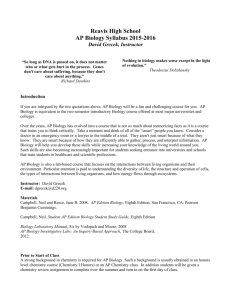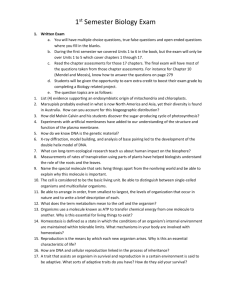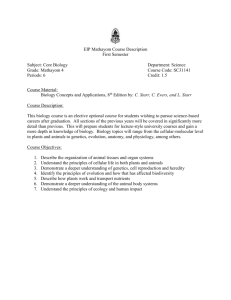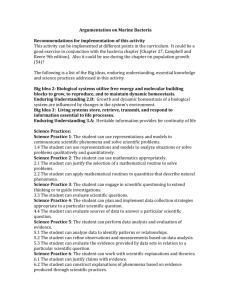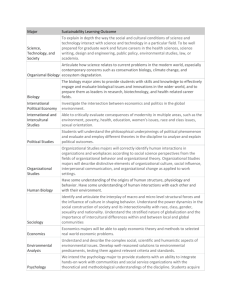AP BIOLOGY SYLLABUS
advertisement
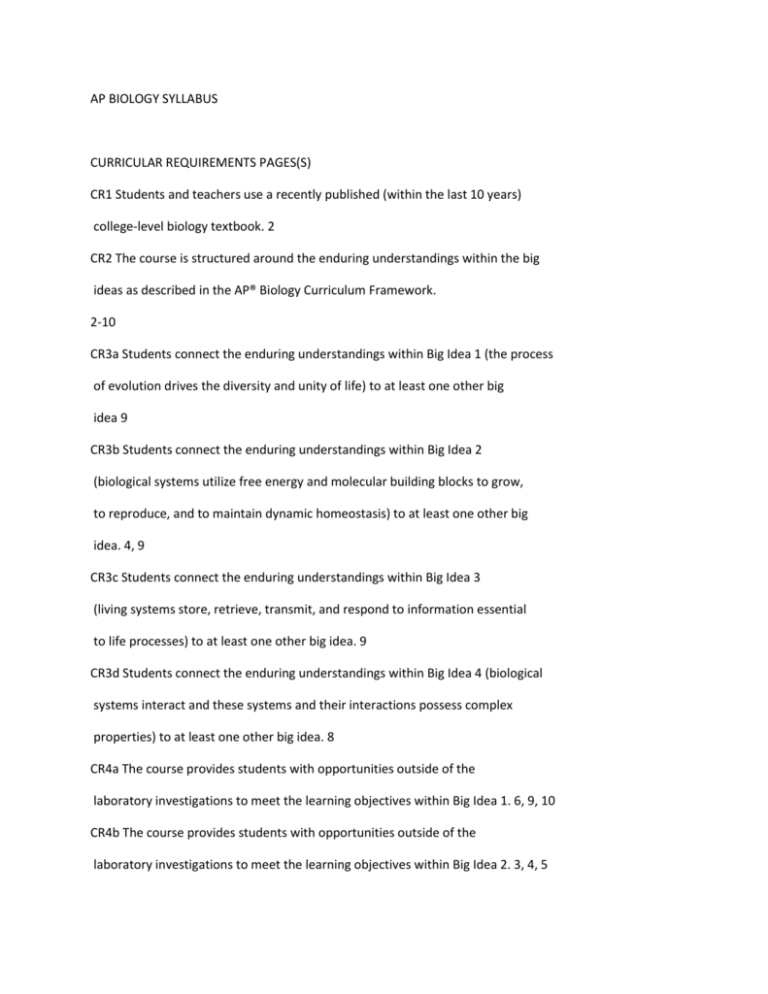
AP BIOLOGY SYLLABUS CURRICULAR REQUIREMENTS PAGES(S) CR1 Students and teachers use a recently published (within the last 10 years) college-level biology textbook. 2 CR2 The course is structured around the enduring understandings within the big ideas as described in the AP® Biology Curriculum Framework. 2-10 CR3a Students connect the enduring understandings within Big Idea 1 (the process of evolution drives the diversity and unity of life) to at least one other big idea 9 CR3b Students connect the enduring understandings within Big Idea 2 (biological systems utilize free energy and molecular building blocks to grow, to reproduce, and to maintain dynamic homeostasis) to at least one other big idea. 4, 9 CR3c Students connect the enduring understandings within Big Idea 3 (living systems store, retrieve, transmit, and respond to information essential to life processes) to at least one other big idea. 9 CR3d Students connect the enduring understandings within Big Idea 4 (biological systems interact and these systems and their interactions possess complex properties) to at least one other big idea. 8 CR4a The course provides students with opportunities outside of the laboratory investigations to meet the learning objectives within Big Idea 1. 6, 9, 10 CR4b The course provides students with opportunities outside of the laboratory investigations to meet the learning objectives within Big Idea 2. 3, 4, 5 CR4c The course provides students with opportunities outside of the laboratory investigations to meet the learning objectives within Big Idea 3. 5, 6, 7 CR4d The course provides students with opportunities outside of the laboratory investigations to meet the learning objectives within Big Idea 4. 6, 9 CR5 The course provides students with opportunities to connect their biological and scientific knowledge to major social issues (e.g., concerns, technological advances, innovations) to help them become scientifically literate citizens. 6, 9 CR6 The student-directed laboratory investigations used throughout the course allow students to apply the seven science practices defined in the AP Biology Curriculum Framework and include at least two lab experiences in each of the four big ideas. 2-10 CR7 Students are provided the opportunity to engage in investigative laboratory work integrated throughout the course for a minimum of 25 percent of instructional time. 2 CR8 The course provides opportunities for students to develop and record evidence of their verbal, written and graphic communication skills through laboratory reports, summaries of literature or scientific investigations, and oral, written, or graphic presentations. 2-10 COURSE OVERVIEW Our school firmly believes in the need to reinforce science topics with relevant activities; therefore, we have a discussion of the day’s assigned topic, according to the topic syllabus, and then follow up with a lab, activity, synthesis understanding question, or video most of the time. Each student comes to class having read and taken additional notes on the assigned reading according to the syllabus. In addition to the investigative labs we are also able to perform a vast number of activities, and other relevant research projects. We also try to cross-curriculum on various topics as much as possible each year. We feel that the recommended curriculum, put forth by Collegeboard, is adequately covered throughout the year and as a bonus we are afforded a couple of weeks to review and prepare to take the AP exam, which is strongly encouraged. INSTRUCTIONAL CONTEXT This is the first year that my high school has offered AP Biology. I will teach AP Biology to seniors on a block schedule during the first semester, the classes are 80 minute classes. During the second semester I will meet with the students during our flex block which is 45 minutes. Ideally, students must have completed both first year biology and chemistry prior to enrolling in AP Biology. I will occasionally allow students to enroll in AP Biology concurrently with introductory chemistry. INSTRUCTIONAL RESOURCES Reece, Jane, et al., Campbell Biology, 7th Edition, Pearson BenjaminCummings. [CR1] Giffen, Cynthia and Heitz, Jean. Practicing Biology (to accompany Campbell-Reece Biology), 3rd Edition, 2008, Pearson Benjamin Cummings. <www.campbellbiology.com>(The website to accompany the main text provides animations, investigations, PowerPoint and other audio-visual sources to enhance instruction) AP Biology Investigative Labs: an Inquiry Based Approach. ADVANCED PLACEMENT BIOLOGY CONTENT My AP course is structured around the four big ideas, the enduring understandings within the big ideas and the essential knowledge within the enduring understanding. [CR2] THE BIG IDEAS: Big idea 1: The process of evolution drives the diversity and unity of life. Big idea 2: Biological systems utilize free energy and molecular building blocks to grow, to reproduce and to maintain dynamic homeostasis. Big idea 3: Living systems store, retrieve, transmit and respond to information essential to life processes. Big idea 4: Biological systems interact, and these systems and their interactions possess complex properties THE INVESTIGATIVE LABORATORY COMPONENT The course is also structured around inquiry in the lab and the use of the seven science practices throughout the course. Students are given the opportunity to engage in student-directed laboratory investigations throughout the course for about 30% of instructional time[CR7]. Students will conduct all 13 inquiry-based investigations [CR6]. Additional labs will be conducted to deepen students’ conceptual understanding and to reinforce the application of science practices within a hands-on, discovery based environment. All levels of inquiry will be used and all seven science practice skills will be used by students on a regular basis in formal labs as well as activities outside of the lab experience. The course will provide opportunities for students to develop, record, and communicate the results of their laboratory investigations. SCIENCE PRACTICES (SP) 1. The student can use representations and models to communicate scientific phenomena and solve scientific problems. 2. The student can use mathematics appropriately. 3. The student can engage in scientific questioning to extend thinking or to guide investigations within the context of the AP course. 24. The student can plan and implement data collection strategies appropriate to a particular scientific question. 5. The student can perform data analysis and evaluation of evidence. 6. The student can work with scientific explanations and theories. 7. The student is able to connect and relate knowledge across various scales, concepts and representations in and across domains. UNITS OF INSTRUCTION UNIT 1—CELL STRUCTURE AND FUNCTION; BIOCHEMISTRY (4 WEEKS) BIG IDEAS: 1, 2, 3 CONNECTED TO ENDURING UNDERSTANDINGS: 1.D—The origin of living systems is explained by natural processes. 2.A—Growth, reproduction, and maintenance of the organization of living systems require free energy and matter. 2.B—Growth, reproduction and dynamic homeostasis require that cells create and maintain internal environments that are different from their external environments. 4A—Interactions within biological systems lead to complex properties. 4B—Competition and cooperation are important aspects of biological systems. 4C—Naturally occurring diversity among and between components within biological systems affects interactions with the environment. Esential Readings: 2.3-2.4, 3.1-3.3, 4.2-4.3, 5.1-5.5, 54.4(Water, Nitrogen, and Phosphorus Cycles), 6.36.7, 7.1-7.5, 36.1-36.3, 40.1, 41.3, 41.4, 42.5, 42.7, 44.3, 44.4 TOPICS COVERED: 1. Cell structure and function including prokaryotic vs. eukaryotic, common characteristics, origins of eukaryotic cells, and the endomembrane system. 2. Biochemistry: types of bonds, the importance of water, water cycle, monomers vs. polymers, dehydration synthesis and hydrolysis, importance of carbon, four major macromolecules, nitrogen and phosphorus cycles. 3. Cell membranes: structure and function, active and passive transport 4. Subcellular components: organelles, organellar membranes, cytoskeleton and extracellular matrix. ACTIVITIES: 1. Diffusion and Osmosis Lab Investigation 4 (from AP Biology Investigative Lab Manual)—(Big Idea 2; SP 1,2, 4, 7); [CR 6,7,8] 2. Emergent Properties and Reductionism Activity (Robert Summers)—Students will practice looking at the ‘big picture’ in biology by assembling puzzles. They will also learn the process of detailed writing by describing the function of various everyday items. 3. pH and pOH Activity (Robert Summers)—Students will differentiate between pH and pOH scales by measuring the pH of various household substances, then calculating the pOH value for each--Big Idea 2; SP 2, 5, 7 4. Enzymes to go activity(Hudson Alpha)-students will learn functions of various enzymes 5. Protein folding activity(Hudson Alpha)-students will learn the importance of protein folding and how proteins fold. From Practicing Biology, 3rd Edition. 1. Activity 4.1/5.1 “How can you identify organic macromolecules?” 2. Activity 4.2/5.2 “What predictions can you make about the behavior of organic macromolecules if you know their structure?” 3. Activity 4.2/5.2 Test Your Understanding “Explain your reasoning as to the outcome of experiments whose outcomes depend on the chemical characteristics of the four major types of macromolecules.” [CR3b] & [CR4b] 4. BUILD-A-MEMBRANE: <http://learn.genetics.utah.edu/> Cut, fold, and paste biological molecules to create a three-dimensional cell membrane with embedded proteins, followed by whole class discussion of membrane structure and function. (SP 1) Students complete animations and activities from Amazing Cells page of this website. [CR3b] PROJECT: Cell State Video Project: Correlate the structures of the cell with the world around you. Various organelles must be included 3in the project. (Robert Summers) [CR4b] UNIT 2—BIOENERGETICS: CELL METABOLISM, PHOTOSYNTHESIS, AND CELLULAR RESPIRATION (4 WEEKS) BIG IDEAS: 1, 2, 4 CONNECTED TO ENDURING UNDERSTANDINGS: 1B—Organisms are linked by lines of descent from common ancestry, 2A—Growth, reproduction and maintenance of the organization of living systems require free energy and matter. 2D—Growth and dynamic homeostasis of a biological system are influenced by changes in the system’s environment. 4A—Interactions within biological systems lead to complex properties. Essential readings: 26.3, 8.1-8.3, 54.1, 8.4-8.5, 40.3, 54.4 (Carbon Cycle), 10.1-10.4, 54.2-54.3, 36.2-36.5, 9.1-9.6, 54.3, 54.4 TOPICS COVERED: 1. Metabolism—Free energy, importance of ATP, enzymes, catabolism and anabolism, coupling reactions, carbon cycle 2. Photosynthesis—Cellular processes, energy flow, primary productivity, trophic structure and food chains. 3. Cellular Respiration—Cellular processes, energy flow, secondary productivity, trophic structure and food chains, anaerobic respiration and fermentation. ACTIVITIES: 1. Enzyme Lab Investigation 13 (AP Biology Lab Investigations)— (Big idea 2; SP 2, 3, 4, 5) [CR6] 2. Photosynthesis Investigation 5 (AP Biology Lab Investigations)— (Big idea 2; SP 2, 3, 4) [CR6] & [CR8] 3. Cellular Respiration Investigation 6 (AP Biology Lab Investigations)-- (Big idea 2; SP 2, 3, 4, 5) [CR6] & [CR8] From Practicing Biology, 3rd Edition (SP 1) 1. Activity 9.1 A Quick Review of Energy Transformations. 2. Activity 9.2 Modeling cellular respiration: How can cells convert the energy in glucose to ATP. 3. Activity 10.1 Modeling photosynthesis: How can cells use the sun’s energy to convert carbon dioxide and water into glucose (10.1 Test Your Understanding) 4. Activity 10.2 How do C3, C4, and CAM photosynthesis compare? (Connection of big idea #2 to enduring understanding 1.A) [CR3a] & [CR4b] THE EVOLUTION OF THE CELL: <http://learn.genetics.utah.edu> The endosymbiotic theory explains how relatives of ancient bacteria ended up in modern-day cells. A whole class discussion is used to analyze the endosymbiotic theory, encouraging students to question how prokaryotes can carry on energy transfer processes without true membrane bound organelles. Students are given 5 minutes to write a conclusion to the discussion on a post-it note for posting on their way out of class. (SP 3, 6) [CR3b] & [CR4b] UNIT 3—CELL COMMUNICATION AND THE CELL CYCLE (3 WEEKS) BIG IDEAS 1, 2, 3, 4 CONNECTED TO ENDURING UNDERSTANDINGS: 1B—Organisms are linked by lines of descent from common ancestry. 2B—Growth, reproduction and dynamic homeostasis require that cells create and maintain internal environments that are different from their external environments. 2C—Organisms use feedback mechanisms to regulate grown and reproduction, and to maintain dynamic homeostasis. 2E—Many biological processes involved in growth, reproduction and dynamic homeostasis include temporal regulation and coordination. 3A—Heritable information provides for continuity of life. 3B—Expression of genetic information involves cellular and molecular mechanisms. 3D—Cells communicate by generating, transmitting and receiving chemical signals. 4A—Interactions within biological systems lead to complex properties. Essential Readings: 12.1, 35.3, 38.2 (Embryo Development), 47.1 (Cleavage), 12.2-12.3, 11.1-11.4 4 TOPICS COVERED: 1. Cell Cycle: process, regulation, intracellular and intercellular signals. 2. Mitosis: phases, relationship to interphase, application of regulatory dysfunction, cancer. 3. Cell signaling: overview of signal transduction, understanding phosphorylation cascade, classes of ligands, membraneand non-membrane bound receptors. ACTIVITIES: 1. Pathways with Friends: <http://learn.genetics.utah.edu> Directed by instructional cards, students kinesthetically model cell communication by acting as components in a cell signaling. Whole class discussion follows, assessing student understanding of cell communication. Animations of Cell Communication, An Example of Cell Communication, The Fight or Flight Response, How Cells Communicate during the Fight or Flight Response (These animations provide students with a model example of the concepts involved in cell signaling). (SP 1) [CR4c] 2. Practicing Biology, 3rd Edition --Activity 11.1 How are chemical signals translated into cellular responses? [CR4c] 3. Whole class discussion: How do hormones and other signaling molecules work? (Animals and Plants, Chapters 11, 40) [CR4c] 4. Modeling the Cell Cycle. Students construct a model of the cell cycle, explain and present the major events in a presentation. (SP 1) [CR4b] 5. Using mitosis cards (such as from Ward’s Natural Science), students estimate the time a cell spends in each of the mitotic stages and develops an appropriate graph to reveal data. (SP 5) [CR4b] Laboratory Investigation 7--Cell Division and Mitosis Introduction—Part 1 of lab only. [CR6] UNIT 4—The Nervous System and the Immune System (2 WEEKS) BIG IDEAS: 1, 2, 3, 4 CONNECTED TO ENDURING UNDERSTANDINGS: 1B—Organisms are linked by lines of descent from common ancestry. 2B—Growth, reproduction and dynamic homeostasis require that cells create and maintain internal environments that are different from their external environments. 2C—Organisms use feedback mechanisms to regulate growth and reproduction, and to maintain dynamic homeostasis. 2D—Growth and dynamic homeostasis of a biological system are influenced by changes in the system’s environment. 3B—Expression of genetic information involves cellular and molecular mechanisms. 3C—The processing of genetic information is imperfect and is a source of genetic variation. 3D—Cells communicate by generating, transmitting and receiving chemical signals. 3E—Transmission of information results in changes within and between biological systems. 4A—Interactions within biological systems lead to complex properties. CHAPTERS: 48.1-48.4, 48.7(Nerve Cell development and Nerve Stem Cells), 49.1-49.4, 43.1-43.5 TOPICS COVERED: 1. Nervous system—Central nervous system, neurophysiology, synapses, integration 2. Immune system—general inflammation, aquired immunity (B-cells, T-cells, clonal selection), HIV/AIDS and autoimmune disorders. ACTIVITIES: From Practicing Biology, 3rd Ed. 1. Activity 43.1 How does the immune system keep the body free of pathogens? 2. Activity 48.2 How do neurons function to transmit information? 3. Jumpin’ the Gap: <http://learn.genetics.utah.edu> Students act out communication at the neural level by behaving as vesicles, neurotransmitters, receptors, secondary messengers and transporters. (SP 1, 7) [CR4d] 4. Research: Can stem cell-based therapy be used in brain and spinal cord injuries? Students will prepare presentations of their findings and responses to questions such as: Should embryonic stem cell research continue to be 5permitted? Should it be supported by government funding? Do the origins of embryonic stem cell lines make a difference? (SP 3) [CR4c] & [CR5] 4. The Immune System, #1281: www.curriculumpathways.com Students will watch a short video on the immune system and complete and online quiz UNIT 5—PLANT AND ANIMAL RESPONSES AND ANIMAL REPRODUCTIN AND DEVELOPMENT (3 WEEKS) BIG IDEAS: 2, 3, 4 CONNECTED TO ENDURING UNDERSTANDINGS: 2A—Growth, reproduction and maintenance of the organization of living systems require free energy and matter. 2B—Growth, reproduction and dynamic homeostasis require that cells create and maintain internal environments that are different from their external environments. 2C—Organisms use feedback mechanisms to regulate growth and reproduction, and to maintain dynamic homeostasis. 2D—Growth and dynamic homeostasis of a biological system are influenced by changes in the system’s environment. 2E—Many biological processes involved in growth, reproduction and dynamic homeostasis include temporal regulation and coordination. 3A—Heritable information provides for continuity of life. 3B—Expression of genetic information involves cellular and molecular mechanisms. 3D—Cells communicate by generating, transmitting and receiving chemical signals. 4A—Interactions within biological systems lead to complex properties. 4C—Naturally occurring diversity among and between components within biological systems affects interactions with the environment. CHAPTERS: 45.1-45.5, 40.4-40.5, 39.1-39.5, 38.1-38.2, 35.5, 21.1 TOPICS COVERED: 1. Endocrine system in Animals—Major hormones: target, source, action. 2. Plant responses to the environment—major hormones: target, source, action. 3. Animal reproduction and development. ACTIVITIES: From Practicing Biology, 3rd Edition: 1. Activity 40.1 How does an organism’s structure help it maintain homeostasis? 2. What affects urine production? <www.campbellbiology.com>, Chapter 44. Through animation, students explore the role of a solute gradient on maximum urine production. Next, they explore the effect of hormones on urine production. Animated experiments are run and data is collected. Students analyze the outcomes of the experiments. (SP 1, 5, 7) [CR4a] 3. Knowing the % of each color in packages of M&M’s, as published by the packaging company, students will count the colors in packages and apply the null hypothesis concept and Chi Square calculations on the data. (SP 2) [CR4c] 4. Students will be given data from a Genetics of Drosophila laboratory involving three crosses of the fruit flies. All of the observations will be given to them. They will develop a null hypothesis as to the mode of inheritance based on the data, and they will use the Chi Square statistical analysis to determine whether to accept or reject the hypothesis. (SP 2, 5) Laboratory Investigation 7--Cell Division and Mitosis, Part 2: Student directed and inquiry based laboratory. Onion roots are treated with bean lectin to increase mitotic rate in cells. Students design a controlled experiment to test the effect of treated root squashes and use Chi Square to analyze data. A write-up of the laboratory and outcome, including calculations and analysis of data will be prepared in the laboratory research notebook. (Big idea 3; SP 2, 3, 4, 5) [CR6] & [CR8] Laboratory Investigation 12--Fruit Fly Behavior Lab. Students design their own controlled experiments to investigate a question they have about animal behavior (kinesis and taxis in isopods, fruit fly behavior with respect to selected stimuli). The entire laboratory and experimental design and analysis will be written in the laboratory research notebook. (Big idea 4; SP 1, 2, 3, 4, 5, 6, 7) [CR6] & [CR8] UNIT 6—GENETIC BASIS OF LIFE, GENE ACTIVITY AND BIOTECHNOLOGY (4 WEEKS) 6 BIG IDEAS—1, 2, 3, 4 CONNECTED TO ENDURING UNDERSTANDINGS: 1A—Change in the genetic makeup of a population over time is evolution. 2C—Organisms use feedback mechanisms to regulate growth and reproduction, and to maintain dynamic homeostasis 2E—Many biological processes involved in growth, reproduction and dynamic homeostasis include temporal regulation and coordination 3A—Heritable information provides for continuity of life. 3B—Expression of genetic information is imperfect and is a source of genetic variation 3C—The processing of genetic information is imperfect and is a source of genetic variation 4A—Interactions within biological systems lead to complex properties 4C—Naturally occurring diversity among and between components within biological systems affects interactions with the environment Essential Readings: chapter 13-20 TOPICS COVERED: 1. Basic DNA: Discovery and Evidence 2. DNA Structure and Replication 3. Central Dogma of Molecular Biology, Transcription and Translation 4. Control of Gene Expression 5. Biotechnology and application of molecular genetics 6. Mendelian Genetics 7. Monogenic and polygenic gene expression 8. Chromosomal Basis of Inheritance 9. Meiosis and gametogenesis ACTIVITIES: 1. Practicing Biology, 3rd Edition. Activity 16.1 Is the hereditary material DNA or protein? Activity 16.2 How does DNA replicate? (modeling) Activity 17.1 Modeling transcription and translation: What processes produce RNA from DNA and protein from MRNA (SP 1, 3, 4, 5, 6) [CR4c] 2. Model of an operon: Following lecture and discussion of structure and function of an operon system, materials are made available for students to create a model of an operon and demonstrate to their classmates. (SP 1, 6) 3. DNA and Histone Model <http://learn.genetics.utah.edu> A 3-D cut-and-paste model depicting how histone, acetyl and methyl molecules control access to DNA and affect gene expression. (Connection of big idea 3 to enduring understanding 4.A; SP 1, 6) 4. Students will use a chromosome bead kit to simulate the process of meiosis and explain when haploidy occurs. (SP 1) Field Trip: Students will travel to a local science center to perform a DNA fingerprinting lab to familiarize them with gel elctrophoresis techniques. (Big Idea 3; SP 4, 5, 7) Lab Investigation 8: Students will use micro-techniques to restrict DNA, and using a marker DNA along with “crime scene” and “suspect” DNA, predict which suspect matches the crime scene. Students will understand the principles of gel electrophoresis.Students will collect quantitative data by using the marker DNA results to graph data. They will utilize band migration distances and extrapolate band sizes by extrapolating from their graphs. The entire laboratory study will be documented in the laboratory research notebook. (Big idea 3; SP 2, 3, 4, 5, 6) [CR6] Lab Investigation 9: Transformation. Students will perform a transformation experiment in which they transform a bacterial cell to contain a plasmid containing a gene which can be expressed so as to produce protein products which make the cell “glow”. Students will then study the structure of the plasmid and make predictions regarding growth on various agar plates (LB plates, plates with ampicillin and arabinose added). They will then examine the bacterial growth afterwards and collect quantitative data. They will calculate transformation efficiency. Students will then plan a controlled experiment that they 7think would improve the transformation efficiency. The entire laboratory study will be documented in the laboratory research notebook. (Big idea 3; SP 2, 3, 4, 5, 6) [CR6] & [CR8] Laboratory Investigation 7, Part 3: Meiosis in Sordaria. Students analyze outcomes of Sordaria crosses, determine phenotypes due to crossover or non-crossover, and determine percent recombination and map units. They will compare their observations with the known map distance from gene to centromere. (SP 2, 5) UNIT 7—ECOLOGY (4 WEEKS) BIG IDEAS: 1, 2, 3, 4 CONNECTED TO ENDURING UNDERSTANDINGS: 1A—Change in the genetic makeup of a population over time is evolution 1C—Life continues to evolve within a changing environment 2A—Growth, reproduction and maintenance of the organization of living systems require free energy and matter. 2C—Organisms use feedback mechanisms to regulate growth and reproduction, and to maintain dynamic homeostasis 2D—Growth and dynamic homeostasis of a biological system are influenced by changes in the system’s environment 2E—Many biological processes involved in growth, reproduction and dynamic homeostasis include temporal regulation and coordination 3E—Transmission of information results in changes within and between biological systems 4A—Interactions within biological systems lead to complex properties 4B—Competition and cooperation are important aspects of biological systems 4C—Naturally occurring diversity among and between components within biological systems affects interactions with the environment Essential Readings: chapters 50-55 TOPICS COVERED: 1. Introduction to ecological concepts: biotic and abiotic factors; brief overview of biomes 2. Ecosystem ecology 3. Review of essential biogeochemical cycles 4. Trophic pyramids and ecosystem energetics 5. Community ecology: interspecific interactions, ideal vs. realized niche, competitive exclusion principle, island biogeography, resource partitioning and character displacement 6. Population ecology: exponential vs. logistic growth, life history patterns, survivorship curves and reproductive strategies ACTIVITIES: 1. Students will design a model of a biome that demonstrates knowledge of biological processes and concepts across scales. Class presentations will demonstrate their knowledge of understanding. (Connects big idea 4 to enduring understanding 2.A; SP 7) [CR3d] & [CR4d] 2. Provide students with a copy of an article entitled “Invasive Plant Suppresses the Growth of Native Tree Seedlings by Disrupting Belowground Mutualisms”, by Kristina Stinson and others. Students will explore the research based study and analyze the data presented for its meaning. (SP 5) [CR4d] & [CR5] 3. Animated investigation: How Does the Fungus Pilobolus Succeed as a Decomposer? From: <www.campbellbiology.com>, Chapter 31. Students investigate this fungus as a decomposer, hypothesizing and collecting data in this animated investigation; they will study the adaptiveness of certain spore dispersal methods. (Connects big idea 4 to enduring understanding 1.A; SP 5, 6, 7) [CR4d] 4. Animated Investigation: How do Abiotic Factors Affect Distribution of Organisms? From: <www.campbellbiology.com>, Chapter 52. Students will use a simple model for observing ecological impact that occurs when single abiotic factors are changes. By changing abiotic factors, data can be collected and analyzed. (Connection of big idea 2 to enduring understanding 4.A) [CR4d] 8 Lab Investigation 10: Ecosystem Energetics [CR6] Lab Investigation 11: Whole Plant Transpiration [CR6] UNIT 8-EVOLUTION AND PHYLOGENY (4 WEEKS) BIG IDEAS: 1, 3, 4 CONNECTED TO ENDURING UNDERSTANDINGS: 1A—Change in the genetic makeup of a population over time is evolution 1B—Organisms are linked by lines of descent from common ancestry 1C—Life continues to evolve within a changing environment 1D—The origin of living systems is explained by natural processes 3A—Heritable information provides fro continuity of life 3C—The processing of genetic information is imperfect and is a source of genetic variation 4C—Naturally occurring diversity among and between components within biological systems affects interactions with the environment Essential Readings: chapters 22-26 22. Descent with Modification: A Darwinian View of Life 23. The Evolution of Populations 24. The Origin of Species 25. The History of Life on Earth 26. Phylogeny and the Tree of Life TOPICS COVERED: 1. The Mechanism of Natural Selection 2. The Evidence for Evolution and Phylogenetics: anatomical evidence, molecular evidence, fossil evidence 3. Biogeography and convergent evolution 4. Building cladograms 5. Population genetics: Populations are the smallest biological system that can evolve, and evolution is driven by changes in allelic frequencies within a population 6. Speciation and macroevolution: reproductive barriers, allopatric vs. sympatric speciation ACTIVITIES: 1. NOVA; PBS video: “What Darwin Never Knew.” This video will be utilized in conjunction with whole class discussions to take a look at Charles Darwin’s observations and conclusions and how modern day molecular biology is confirming what Darwin documented. (Connects big idea 1 to enduring understanding 3.C) [CR3c], [CR4a] & [CR5] 2. Constructing a Phylogenetic Tree Using DNA Sequence Data Simulation: <http://www.accessexcellence.org/AE/> Students exchange the “ancestral DNA” with random mutations over time and make divergences into different evolutionary lines. A phylogenetic tree is constructed. Then, in a second part, students construct a phylogenetic tree of another group based strictly on nucleotide sequences of present-day organisms. (SP 1, 4, 5) [CR4a] 3. Evolutionary Time: The Geologic Time String <http://www.accessexcellence.org/AE> The Time String involves the use of a string. The string is 4.6 meters long, and each millimeter on the string represents 1 million years. Knots tied at distinct locations along the string represent extinctions, beginning of Eras, and so forth, in the geologic time table. (SP 7) [CR4a] 5. Practicing Biology, 3rd Edition.-- Activity 23.1 A Quick Review of HardyWeinberg Population Genetics. Alternatively, present students with HardyWeinberg problems from a variety of resources. Students apply the HardyWeinberg equation to determine frequencies of phenotypes and alleles. (SP 2) [CR4a] 6. Wooly Worms Activity <http://www.accessexcellence.org> Lab Investigation 1—Artificial Selection [CR6] Lab Investigation 2—Mathematical Modeling of Hardy-Weinberg Equilibrium [CR6] 9UNIT 9—BIODIVERSITY (3 WEEKS) BIG IDEAS: 1, 2, 3, 4 CONNECTED TO ENDURING UNDERSTANINGS: 1A—Change in the genetic makeup of a population over time is evolution 1B—Organisms are linked by lines of descent from common ancestry 2A—Growth, reproduction and maintenance of the organization of living systems require free energy and matter 2C—Organisms use feedback mechanisms to regulate growth and reproduction, and to maintain dynamic homeostasis 2D—Growth and dynamic homeostasis of a biological system are influenced by changes in the system’s environment 2E—Many biological processes involved in growth, reproduction and dynamic homeostasis include temporal regulation and coordination 3E—Transmission of information results in changes within and between biological systems 4A—Interactions within biological systems lead to complex properties 4B—Competition and cooperation are important aspects of biological systems Essential Readings: chapter 26-34 TOPICS COVERED: 1. Origins of Life: review of prokaryotic and eukaryotic cells, review of endosymbiosis 2. Overview of Protists, multicellular heterotrophs, fungi, invertebrates, vertebrates 3. Multicellular autotrophs: the four major plant clades with an emphasis on angiosperm reproductive strategies ACTIVITIES: 1. Practicing Biology, 3rd Edition. Activity 29.3 How are the events in plant evolution related? Activity 34.1 What can we learn about the evolution of chordates by examining modern chordates? Activity 36.1 How are water and food transported in plants? Lab Investigation 3. Students will learn how to analyze cladograms and understand evolutionary relationships using the Basic Local Alignment Sequencing Tool. Students will analyze morphological details about a newly discovered fossil, hypothesize as to the position of the fossil in a pre-constructed cladogram, then test the hypothesis using BLAST. Once students become comfortable, they will use the tool to answer questions of their choice regarding gene sequences. Alternatively, students can explore and discover using Cold Spring Harbor DNA Learning Lab: DNA Subway. (Big idea 1; SP1, 3, 4, 5) [CR6] & [CR8] 1



